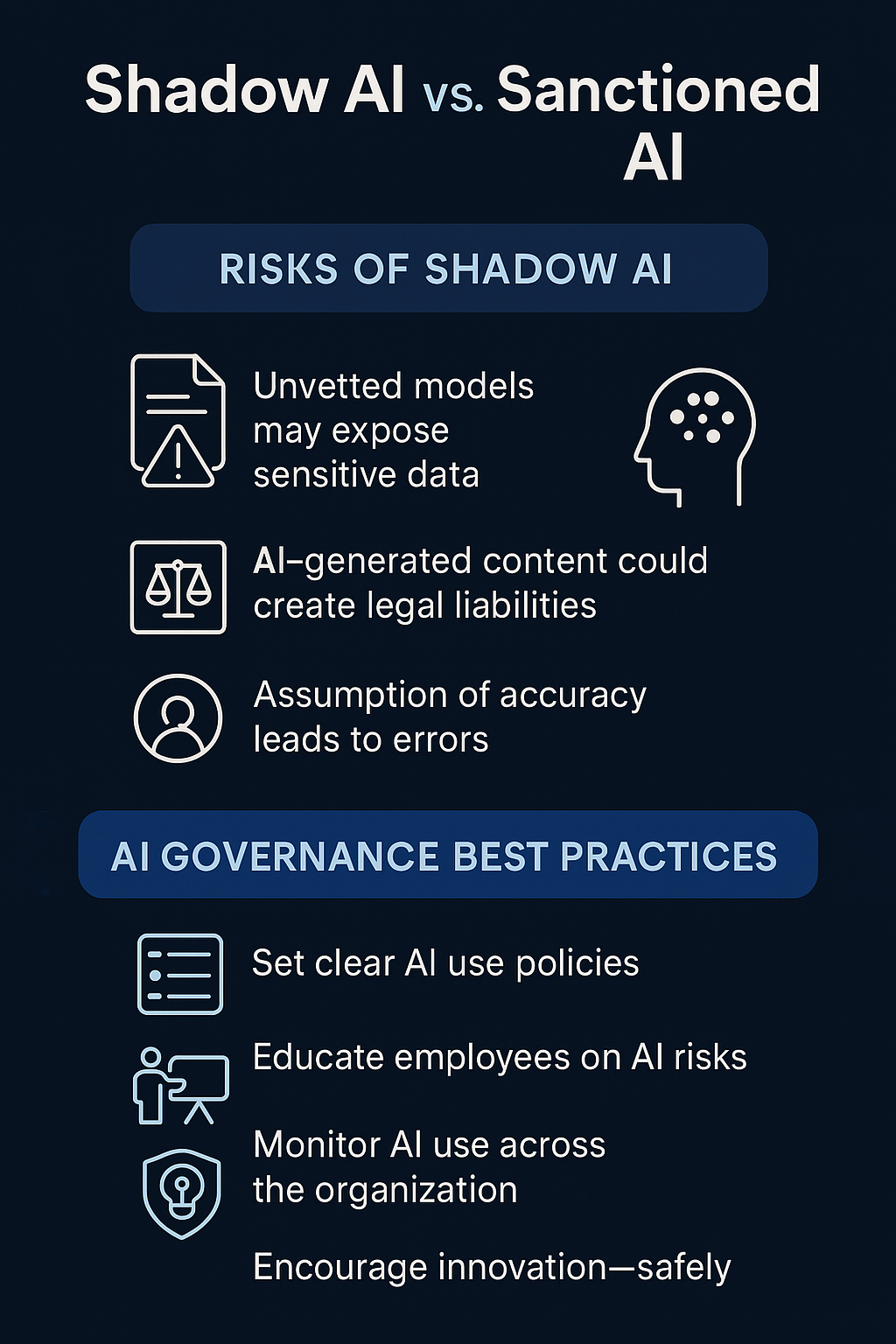How to prevent Shadow AI risks while embracing AI innovation
Artificial Intelligence (AI) is reshaping workplaces, but not always in ways IT and security leaders anticipate. Shadow AI—employees using unapproved AI tools without oversight—poses significant risks to security and compliance. Much like Shadow IT, which introduced vulnerabilities through unauthorized software, Shadow AI risks like data leaks and regulatory violations are a growing concern. This article explores how to manage Shadow AI in the workplace while leveraging sanctioned AI tools for productivity and innovation.
The Risks of Shadow AI: Real-World Examples
Shadow AI can lead to costly consequences, as shown in recent incidents:
- Financial Sector Breach: In 2024, a financial firm found employees using generative AI to draft client communications. Unknowingly, they fed confidential data into an unvetted model, risking compliance violations and triggering a security audit Learn more about AI compliance risks [Source].
- Healthcare Compliance Risk: A clinician used an unapproved AI chatbot to summarize patient notes, exposing sensitive data to potential HIPAA violations. This highlights how Shadow AI can jeopardize regulatory compliance. [Source]
A 2024 IBM study estimates 30% of enterprises face Shadow AI risks, with potential losses averaging $1.5M per breach [Source].

Why Shadow AI Is Riskier Than Traditional Shadow IT
Unlike conventional software, AI learns and processes vast datasets, amplifying risks. Employees often turn to Shadow AI due to limited access to user-friendly sanctioned tools, cumbersome approvals, or lack of awareness. Here’s why Shadow AI is dangerous:
- Data Exposure: Unvetted AI models may store sensitive information, increasing leak risks.
- Legal Liabilities: Incorrect AI-generated content can violate regulations.
- Misinformation: Employees may trust inaccurate AI outputs, causing errors.
- Scalability of Errors: A single unapproved AI tool can process thousands of data points, amplifying breaches.
Best Practices for AI Governance and Shadow AI Prevention. Managing Shadow AI requires guardrails to ensure safe AI use.
✅ Here are five strategies for AI governance best practices:
1️⃣ Establish a Clear AI Governance Policy
Define rules for AI use:
- Specify approved and prohibited AI tools.
- Outline data handling protocols.
- Provide escalation paths for AI-related risks.
💡 Tip: Align with existing cybersecurity frameworks Explore our cybersecurity resources (link).
2️⃣ Provide Secure, Sanctioned AI Tools
Prevent Shadow AI by offering accessible tools:
- Use enterprise-grade platforms like Microsoft Copilot or Salesforce Einstein.
- Ensure tools integrate into workflows.
💡 Tip: Choose vendors compliant with data residency requirements.
3️⃣ Monitor Shadow AI Usage
Maintain visibility:
- Deploy tools to detect unauthorized AI use.
- Analyze usage patterns for high-risk behaviors.
💡 Tip: Incorporate AI monitoring into insider risk programs.
4️⃣ Educate Employees Early and Often
Empower employees through:
- Gamified training (e.g., quizzes) on AI risks.
- Real-world examples of AI misuse.
💡 Tip: Position employees as risk management partners.
5️⃣ Create a Feedback Loop
Evolve AI governance:
- Encourage reporting of new AI use cases.
- Update policies regularly.
💡 Tip: Form a cross-functional AI risk committee.
Key Takeaways
- Shadow AI risks include data leaks, legal issues, and amplified errors.
- Employees use unapproved tools due to access or awareness gaps.
- Governance, secure tools, monitoring, education, and feedback mitigate risks.
Conclusion: Secure AI with Proactive Oversight
Shadow AI risks can undermine your organization, but robust AI governance policies and oversight can prevent vulnerabilities. Take control today to harness AI’s power safely.




